What if there was a way you could show your willingness to kōrero Māori with others in public? Leonie Hayden talks to the brains behind a range of t-shirts, jumpers and badges letting people know the wearer can, or wants to, speak to others in te reo Māori.
For Paul Andersen (Ngāti Raukawa) the challenge presented itself when he was shopping with his tamariki in Ōtaki.
“After hearing me speak in te reo to my children, the shop assistant served us in te reo. Since that time I have had a few occasions when shopping where I have been keen to use te reo, but couldn’t tell whether the staff were able or keen to kōrero Māori.”
He admits having āhua Pākehā, or not presenting visibly as Māori, is another barrier. “You generally can’t tell if someone is a speaker just by looking at them.”
An idea was born – a range of t-shirts, jumpers and badges emblazoned with Kōrero Māori Mai (Speak Māori To Me) that let people know the wearer can, or wants to, speak to others in te reo Māori.
Like so many others, te reo Māori was lost in Paul’s whānau during his Grandma Irene’s generation. Growing up in Foxton, she was strapped at school for speaking it. She was distanced further when her mother died of pneumonia during the Depression and she took on the role of caregiver to her six younger siblings despite only being 14-years-old. This meant that she had little time (or a vehicle) to maintain contact with her marae and Māoritanga.
Paul took up the subject at high school, an option not offered to his older siblings – his sister Ellen had to gain special permission from her college to enrol in The Correspondence School to learn te reo Māori.
“I started at St Pat’s [St Patrick’s College in Wellington] in 1994, the same year that they started offering it as a language option. The first year we had a full class. The next year there were four of us, and by fifth form on I was the only one from my year group until I finished at a bursary level in 1998. I did a bilingual teaching degree through Victoria University before teaching at a number of schools in the Wairarapa including Te Kura Kaupapa Māori o Wairarapa.”
He’s now lead teacher of te reo Māori at Lakeview School in Masterton and is taking a year off to study a post-grad diploma in immersion teaching at Te Wānanga o Raukawa.
Although the badges and t-shirts are part of a language revitalisation assignment for Te Wānanga o Raukawa, his vision is for Kōrero Māori Mai to be widely embraced by businesses. “Businesses such as supermarket chains and councils would make these available for staff who are keen to kōrero with customers and in doing so increase the amount of te reo Māori used in the community… I have come across former students who I taught at Te Kura Kaupapa Māori o Wairarapa while shopping and wondered if their employers recognised their ability to kōrero Māori with customers as an asset.”
The majority of the money raised will be going to his marae – Te Pou o Tainui in Ōtaki – towards their wharekai fund. He’s also creating a resource for teaching te reo Māori in mainstream schools called ‘He Kākahu Reo’, which he says will be ready before the end of the year.
Kōrero Māori Mai t-shirts, jumpers and badges are available to buy now plus you can win a jumper or t-shirt of your choice with Ātea! Go to the Ātea Facebook page and comment where you would most like to be able to kōrero Māori. We’ll choose two winners on Rāmere te 14 o Māhuru (Friday 14 September).
